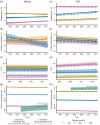Shifts in avian migration phenologies do not compensate for changes to conditions en route in spring and fall
- PMID: 40383990
- PMCID: PMC12086353
- DOI: 10.1002/ecy.70110
Shifts in avian migration phenologies do not compensate for changes to conditions en route in spring and fall
Abstract
Several factors are known to affect bird migration timing, but no study has simultaneously compared the effects of temperature, land surface phenology, vegetation greenness, and relative humidity in both spring and fall. In addition, it is unclear whether long-term shifts in migration phenologies have kept pace with changing climates. For example, if migration shifts earlier in the spring, temperatures on migration dates may remain stable over time despite spring warming trends. If the phenologies of birds, plants, and insects shift asynchronously in response to changing climates, then birds may encounter reduced resource availability during migration. We estimated spring and fall 10%, 50%, and 90% cumulative migratory passage dates at 53 weather surveillance radar stations across the US Central Flyway. We determined which conditions (temperature, timing of green-up and dormancy, relative humidity, and enhanced vegetation index [EVI]) explained annual variation in migration phenologies. We also described decadal trends in environmental conditions and whether shifts in migration phenologies were sufficient to compensate for these changes. Annual changes to spring migration phenologies were best explained by anomalies in temperature, with earlier passage in warmer years. Fall migration occurred later on warmer, more humid years with higher EVI and later dormancy. Long-term adjustments in bird migration phenologies did not mitigate their exposure to changing environmental conditions. Although passage dates for all spring migration quantiles advanced significantly (~0.6 days/decade), temperatures on spring 10% passage dates increased, while 50% and 90% passage occurred closer to green-up. In the fall, temperatures increased on 50% and 90% passage dates. By contrast, the advancement of 10% passage (~1 day/decade) prevented early migrants from experiencing the cooling late-summer temperature trend. Warmer temperatures in mid to late fall may lead to earlier fruiting phenology and asynchronies with migratory passage, which occurred later in warmer years. Changes in temperature and land surface phenophases experienced by migrants suggest that resource availability during migration has changed and that adjustments to migration phenologies have not compensated for the effects of changing climates.
Keywords: aeroecology; aves; birds; climate change; green‐up; land surface phenology; migration; phenology; radar ornithology.
© 2025 The Author(s). Ecology published by Wiley Periodicals LLC on behalf of The Ecological Society of America.
Conflict of interest statement
The authors declare no conflicts of interest.
Figures



Similar articles
-
Chasing and surfing seasonal waves: Avian migration through the US tracks land surface phenology in fall, but not spring.J Anim Ecol. 2024 Jul;93(7):836-848. doi: 10.1111/1365-2656.14088. Epub 2024 May 13. J Anim Ecol. 2024. PMID: 38741512
-
Six decades of North American bird banding records reveal plasticity in migration phenology.J Anim Ecol. 2023 Mar;92(3):738-750. doi: 10.1111/1365-2656.13887. Epub 2023 Jan 30. J Anim Ecol. 2023. PMID: 36655993
-
The influence of climate on the timing and rate of spring bird migration.Oecologia. 2005 Jan;142(2):307-15. doi: 10.1007/s00442-004-1725-x. Epub 2004 Oct 5. Oecologia. 2005. PMID: 15480801
-
Phenological and elevational shifts of plants, animals and fungi under climate change in the European Alps.Biol Rev Camb Philos Soc. 2021 Oct;96(5):1816-1835. doi: 10.1111/brv.12727. Epub 2021 Apr 27. Biol Rev Camb Philos Soc. 2021. PMID: 33908168 Review.
-
Community-science reveals delayed fall migration of waterfowl and spatiotemporal effects of a changing climate.J Anim Ecol. 2024 Apr;93(4):377-392. doi: 10.1111/1365-2656.14055. Epub 2024 Mar 14. J Anim Ecol. 2024. PMID: 38482727 Review.
References
-
- Bartomeus, I. , Ascher J. S., Wagner D., Danforth B. N., Colla S., Kornbluth S., and Winfree R.. 2011. “Climate‐Associated Phenological Advances in Bee Pollinators and Bee‐Pollinated Plants.” Proceedings of the National Academy of Sciences of the United States of America 108: 20645–20649. 10.1073/pnas.1115559108. - DOI - PMC - PubMed
-
- Both, C. , Ubels R., and Ravussin P.‐A.. 2019. “Life‐History Innovation to Climate Change: Can Single‐Brooded Migrant Birds Become Multiple Breeders?” Journal of Avian Biology 50: 1–7. 10.1111/jav.01951. - DOI
MeSH terms
Grants and funding
LinkOut - more resources
Full Text Sources
Medical
Research Materials
